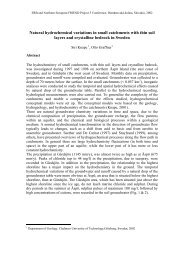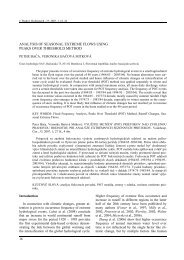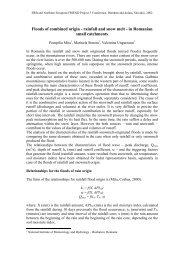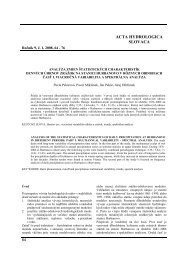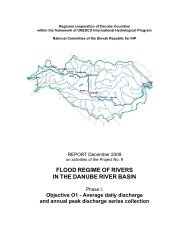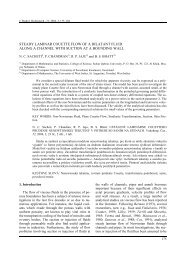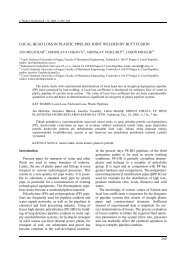TIME SERIES ANALYSIS OF HYDROLOGIC DATA FOR WATER ...
TIME SERIES ANALYSIS OF HYDROLOGIC DATA FOR WATER ...
TIME SERIES ANALYSIS OF HYDROLOGIC DATA FOR WATER ...
You also want an ePaper? Increase the reach of your titles
YUMPU automatically turns print PDFs into web optimized ePapers that Google loves.
Time series analysis of hydrologic data for water resources planning and management: a reviewAll the stochastic models proposed to representhydrologic time series have attempted to reproduceor incorporate the persistence phenomenon; however,with the time series records commonly availablein hydrology, it is virtually impossible to identifyany long-term persistence in the data (Capodaglioand Moisello, 1990).Although some researchers have presented reviewson trend detection and estimation techniquesin the past (Esterby, 1996; Hess et al., 2001), acomprehensive review encompassing the applicationpotential of time series analysis techniques inhydrology and climatology is lacking. Esterby(1996) reviewed some parametric and nonparametrictrend detection methods by confining their applicationto water-quality time series, while Hess etal. (2001) presented an overview of six linear trenddetection methods used for environmental timeseries. Thus, the earlier reviews focused on a singlecharacteristic (i.e., trend) of the time series, with anemphasis on some favored techniques only. At thedawn of 21st century, there is a need to highlightthe role of time series analysis in water resourcesplanning and management amidst emerging newissues of sustainable water management. Therefore,in the present study, an attempt has been made topresent a review of the application of time seriesanalysis techniques in hydrology and climatology.There has been a dramatic increase in the applicationof time series analysis in hydrology during pastfour or five decades. However, the present reviewmainly includes the research findings reported duringpast ten years bearing in mind the size of a reviewpaper.2. Overview of the tests for determining varioustime series characteristics2.1 Homogeneity or consistencyAs mentioned earlier, homogeneity implies thatall the collected data belong to the same statisticalpopulation having a time invariant mean. Therefore,the tests to check the homogeneity of dataseries are based on evaluating the significance ofchanges in the mean value. The features of threehomogeneity tests viz., the von Neumann Test,Cumulative Deviations, and the Bayesian Test arediscussed in Buishand (1982) and Jayawardena andLau (1990). In these studies, all the three tests havebeen used as test statistics.Buishand (1982, 1984) presents detailed methodologyfor the above-mentioned three homogeneitytests, which serves as major guidelines for thesetests. Kanji (2001) in his excellent collection of 100statistical tests, have reported various homogeneitytests for multiple comparisons (e.g., Tukey, Link-Wallace, Dunnett, Bartlett, and Hartley tests).However, it has major drawbacks that the objectivesof tests are not clear and that original referencesare missing. On the other hand, some researchers(e.g., Radziejewski et al., 2002) have consideredonly a few homogeneity tests in the list oftrend detection tests. Such a reference may createconfusion about the general perception of homogeneityand trend for the researchers having no accessto other references. In the hydrologic time seriesanalysis, multiple comparison tests are still contemporary,while these tests are considered classical inthe geotechnical field (e.g., Phoon et al., 2003).2.2 StationarityA time series is said to be strictly stationary, ifits statistical properties do not vary with changes oftime origin. That is, if two non-overlapping timeintervals are selected from a given time series, thenthe two subseries will look almost the same. In fact,both the subseries will differ from one another, butwill be scattered around the same mean value.Therefore, a stationary time series cannot have anytrend or periodic component. This is the reason thatsometimes trend and periodicity tests are used tocheck the stationarity of hydrologic time series.There are two general approaches for testing stationarity:parametric and nonparametric. A detailedreview of the literature indicated that the parametricapproach is usually used by the researchers workingin the time domain, such as economists, who makecertain assumptions about the nature of their data.On the other hand, the nonparametric approach ismore commonly used by the researchers working inthe frequency domain, such as electrical engineers,who often treat the system as a "black box" andcannot make any basic assumptions about the natureof the system. In hydrology, however, bothparametric and nonparametric approaches are used.Furthermore, nonparametric tests are not based onthe knowledge or assumption that the population isnormally distributed (Bethea and Rhinehart, 1991).Therefore, the nonparametric tests are more widelyapplicable than parametric tests. However the nonparametrictests are reported to be less powerfulthan parametric tests. To arrive at the same conclusionwith the same confidence level, the nonpara-239



